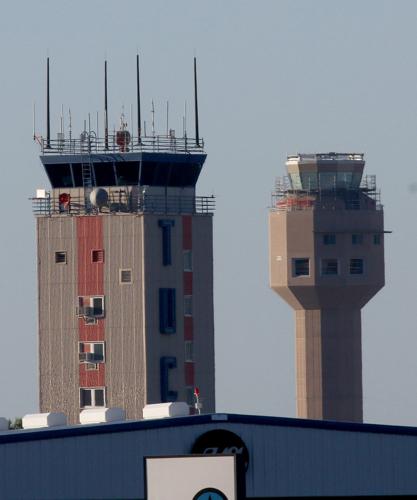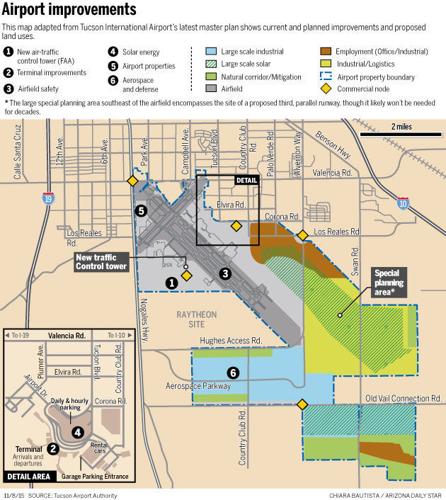A new air-traffic control tower rising 12 stories above the skyline on Tucson’s south side is a visible sign of progress at Tucson International Airport.
And you’ll see a lot more construction in and around TIA as the airport moves forward with more than $200 million worth of long-term building projects across the sprawling airport property.
Some projects are virtually invisible to the flying public — like a recently completed, multiyear $42 million project to repave all of TIA’s airfield aprons, or ramp areas where planes board passengers.
Others, like a major terminal makeover set to start as soon as late spring, will become readily apparent as crews chip away at the work and passengers are routed around construction zones.
While construction of some sort seems to always be going on at TIA, projects underway or pending may make the next five years the most intense building period in decades.
Planned airfield safety improvements, including expansion of one of TIA’s two parallel runways starting in 2020, will cost an estimated $180 million, to come from FAA funding and TIA revenue bonds and start construction by 2020.
It’s the biggest capital project at TIA since the airport added two concourses and a flight kitchen in the early 1980s, said Bonnie Allin, president and CEO of the Tucson Airport Authority.
“It is the largest and very, very significant for an airport our size,” Allin said.
One of the most visible near-term projects is the terminal makeover, which will reconfigure ticket counters, expand security corridors and create areas for new amenities including a new bar and retail area in the center of the ticketing level.
That project, still in the design phase, will open up the terminal and allow room for more amenities and shops.
“It’s just going to be a completely different feel, and we’re going to continue to feature Southern Arizona,” Allin said, noting that decorations will highlight Tucson’s high-tech chops while TIA expands areas where local artists and performers can showcase their talents.
Other projects are meant to boost economic development at and around the airport, including a plan to improve several airport-owned industrial properties and efforts to create an aerospace and defense corridor south of TIA. The airport has hired commercial real-estate broker CBRE to market the properties after traditionally handling those duties in-house.
A 2012 report by the University of Arizona’s Eller College of Management estimated TIA’s annual economic impact at $3.2 billion. The airport is self-sufficient, funding operations with user fees.
“We’ve got some older facilities, some going back to the 1950s, and people move in and out of them,” Allin said. “We’re really trying to attract companies with long-term, stable job-creation outlooks.
“The more the airport can be an economic catalyst for our region,” she said, “everyone benefits.”
TUCSON AIRPORT IMPROVEMENTS
(numbers keyed to map)
1. Air-traffic control tower
What they’ll do: The Federal Aviation Administration is building a new, state-of-the-art control tower on the west side of the airfield.
What it will look like: The shell of the 252-foot tower is nearly complete, though perhaps not immediately apparent to travelers in the terminal.
Why they’re doing it: The current tower, built in 1958 on the northeast side of the airfield, is the nation’s second-oldest FAA control tower. The old tower, which will be saved for office space and other uses, is too short and poorly positioned by today’s standards, leading to safety concerns.
When it will happen: In 2016, the new tower’s equipment will be installed, and the tower will be commissioned. It will operate in conjunction with the old tower for a year before being declared fully operational in 2017.
How much it will cost: $42 million, fully funded by the FAA through taxes on passengers, cargo and fuel.
2. Terminal improvements
What they’ll do: Move airport administration offices from various locations to the terminal’s third floor (ongoing); reconfigure the terminal, including ticket counters; relocate and widen federal security checkpoints; expand post-security areas to provide new passenger services; backbone infrastructure improvements for the 50-year old building.
What it will look like: Ticket counters will be shifted and some areas will be periodically closed off during construction. A counter shuffle already is underway as the operations of the former US Airways are merged into American Airlines.
Why they’re doing it: The reconfigured airport terminal will better meet changing needs, including fewer air carriers and wider security checkpoints, and to provide better traffic flow and more visitor amenities.
When it will happen: Airport offices were recently moved. Terminal design should be complete by January and construction is to begin by late next spring or early summer and continue until the fall of 2017.
How much it will cost: $33 million.
3. Airfield safety
What they’ll do: Build a new center parallel taxiway between TIA’s two main runways; relocate the existing general aviation runway about 90 feet and widen and lengthen it for use as a commercial service runway.
What it will look like: Construction will be visible on the airfield, but it isn’t expected to affect air traffic.
Why they’re doing it: The project will create a second commercial-rated runway and eliminate confusing crossing taxiways that can lead to dangerous runway incursions.
When it will happen: Construction is expected from 2020 to 2022. The airport is selecting a consultant to perform a required environmental impact statement, which will take more than three years. Design is expected to be completed in 2019.
How much it will cost: About $180 million, with TIA’s share to be determined.
4. Solar energy
What they’ll do: A 2.5-megawatt solar photovoltaic canopy will cover the short-term parking lot in front of the terminal, and additional solar arrays will be built on the parking garage and the economy parking lot.
What it will look like: The airport already has installed about 1 megawatt of solar panels arranged as shade cover over much of the daily section of the short-term parking lot. The rest of the lot will be covered and plans call for walls of vegetation to create a cooling microclimate. Additional arrays will be installed over the rest of the daily lot and the hourly lot, for a total 2.5 megawatts when all phases are completed.
Why they’re doing it: To save energy and money. The current parking lot array serves the airport’s main utility plant, and when it is finished the installation will feed power to the concourses, meeting much of the terminal’s power demand.
When it will happen: The airport is bidding out the second phase of the solar parking canopies, for construction to start by next summer.
How much it will cost: $6.7 million for the terminal lot project (funding includes a $5.7 million FAA grant and $280,000 from the state); $11.2 million projected for the second phase.
5. Airport properties
What they’ll do: Various projects to improve the “curb appeal” of properties the airport leases, and reroofing the Tucson Industrial Center building, consisting of three 192,000-share-foot hangars on the airport’s west side.
What it will look like: Exterior improvements including paint, low-water-use landscaping and streetscaping.
Why they’re doing it: To attract new tenants to lease airport properties and maintain the industrial building.
When it will happen: Improvements are ongoing, with the roof job scheduled for next year.
How much it will cost: $445,000 has been approved for specific projects, with $375,000 in a reserve fund; $2.3 million to reroof Tucson Industrial Center.
6. Aerospace and defense corridor
What they’ll do: Though not funded or managed by TIA, the airport is a key player in Pima County’s effort to create an aerospace and defense business corridor south of the airport. The Airport Authority owns significant chunks of land in the corridor and stands to eventually gain from leases of airport property.
What it will look like: Expect continued road and infrastructure work as crews work on the new connection for Hughes Access Road and Aerospace Parkway.
Why they’re doing it: The new parkway provides a wider buffer to Raytheon, which picked Huntsville, Alabama, over Tucson for a major expansion in 2010 partly because of the lack of adequate buffer space. Proposed industrial parks would provide additional buffer and boost aerospace economic development, backers say.
When it will happen: Ongoing. In October, traffic was diverted from the former Hughes Access road to Raytheon Missile Systems’ campus to the new Aerospace Parkway, and other road work continues there. The airport is coordinating land deals with the Air Force, Pima County, Raytheon and the FAA to make way for development and is developing a utility infrastructure plan for the area.
How much it will cost: The Hughes Access Road realignment is expected to cost about $8 million; Pima County had sought $30 million in its recently failed bond package for initial phases of the Sonoran Corridor, a proposed 16-mile, $600 million highway linking I-19 to I-10 south of the airport.





